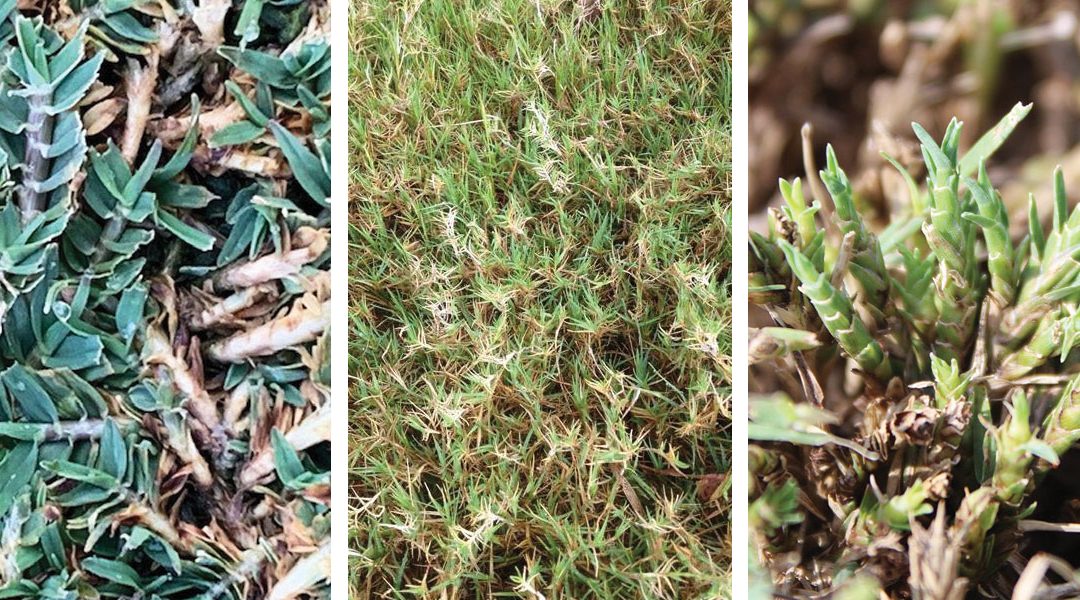Heat and drought stress across much of the country is promoting the colonisation success of the familiar Couch Mite. Peter Kirby (right), agronomist and chemical expert explains how this troublesome Couch Mite and other mites manipulate the turf plant’s defences and causes havoc for growers.
With high temperatures expected to be a big challenge facing the future of agriculture, farm management such as pest control, must keep abreast with this change.
Drought is considered one of the main environmental factors limiting turf growth and yield. And as Couch Mites appear to flourish in hot dry conditions the joint action of heat stress and mite invasive on turf causes major nutritional issues and subsequently affects yield.
Moving forward, to manage this issue in the future, resistant turf varieties are been researched and recommended, alternately, an effective chemical spray program is suggested.
There are also several other mite families, presently impacting plants in Australia. Couch Mite is classified as an Eriophyid mite and according to previous research by Turf Breeding and Research Expert Peter McMaugh, there are other eriophyid mite species in Australia which feed on Zoysia species.
Couch Mite Activity and Lifecycle
Couch Mites (Aceria cynodoniensis) are microscopic organisms that come from the arachnid class (the same class as spiders and scorpions). They breed quickly, have a short life span and occur in their millions. The mite is very host specific, and only attacks Couch (Cynodon dactylon) turf.
In 2014 research by Kimberly Schofield, an expert in Integrated Pest Management from the Texas A&M University suggested that the finer textured ‘Tif’ varieties of Couch showed some tolerance to Couch Mite attack.
The first noticeable damage of Couch Mite to turf often occurs in spring. This is when turf fails to thrive as it normally would and temperatures increase, in spite of plenty of water and fertiliser.
Couch Mite completes a lifecycle within a very short space of time (7-10 days) and can complete several generations a year.
As a result, again according to Ms Schofield’s research, in ideal conditions (such as drought), numbers of the mite can build very rapidly, and damage can be extensive if not controlled.
Adults of the mite are extremely small and can only be seen with a minimum 10X hand lens magnifier. They are creamy white to yellow in colour, an elongated body shape and have four legs near the head end. They are found behind the leaf sheath sucking plant sap/juices.
Eggs
Eggs are spherical, transparent to clear white and are deposited singly or in groups behind the leaf sheaths.
Nymphs
Nymphs resemble the adults in being microscopic and are about two-thirds the size of the adults. The nymphs may be observed behind the leaf sheath sucking plant sap/juices. Upon hatching the nymphs molt twice (2 instars) and molt again into a sexually mature adult. All stages of development may be found behind the leaf sheath.
The following diagram outlines the Couch Mite lifecycle in more detail.
Figure 1: Lifecycle of the Couch Mite

Temperature and Couch Mite
Couch Mite is active primarily in late spring and summer. Although Couch Mite can survive atmospheric temperatures up to 50°C, optimum temperatures for the Mite’s growth and survival are between 20° and 40°C.
During winter the mite lies beneath the leaf sheaths in the crowns of Couch and becomes active again as temperatures increase.
Couch Mite Symptoms
Couch Mite spend most of their lives beneath the leaf sheath and up to 200 mites can occur under one leaf.
Initial damage symptoms are found on the leaf tip which looks yellow and distorted.
Couch Mite with their piercing and mouthparts suck juices from the stems and leaf sheaths. They also inject a toxic saliva into the plant. As a result, internodes shorten and leaf sheaths swell, resulting in the ‘witches broom’ affect that is commonly observed.
Damage first appears in spring with dieback and browning occurring in the summer months.
Other Turf Mites
Peter McMaugh undertook an Australian wide survey in 2011 (Screening chemicals for control of eriophyid mites in four warm season turf grasses) the results established that based on frequency of occurrence, Dolichotetranychus species (spp) mites were as important, if not more, than eriophyoid mites on Australian turf.
Mr McMaugh found that the Dolichotetranychus spp of mites affected Common Couch, Kikuyu, Zoysia and Queensland Blue Couch.
False Spider Mites
The Dolichotetranychus spp mites, known mostly as False Spider Mites, are known to be slow-moving therefore infestations on Common Couch typically appear as concentrated patches.
Mr McMaugh found that False Spider Mites appeared to remain active on Kikuyu even through the winter in the cooler climates of Australia, such as Melbourne.
Grass Webbing Mites
Grass Webbing Mites affect a wide range of plant species including Common Couch, Queensland Blue Couch, Kikuyu and Buffalo turf varieties.
They feed on the leaves, like most mite species, creating damage to the plant’s surface with their stylet mouthpieces.
There are two Grass Webbing Mite species identified by Mr McMaugh in Australia, Oligonychus araneum and Oligonychus digitatus. These species produce a distinctive protective circular webbing which is woven over the top of the colony and is a clear sign of their presence in turf.
Chemical Control of Mite Species in Australia
Abamectin
Abamectin is registered in Australia as Thumper, Agador and Abacin for the control of Couch Mite. Abamectin is a translaminar miticide that controls the feeding stages of mites. It controls mites by working on their nerve and muscle systems by enhancing levels of glutamate (a neurotransmitter in insects) at the glutamate-gated chloride channel.
By activating the glutamate-gated chloride channels, the Mite becomes paralysed, stops feeding and dies.
Clofentezine
Clofentezine is registered in Australia as Prophesy and Apollo for the control of Couch Mite. Clofentezine is a specific acaricide (miticide) that works via contact action, with known long residual activity.
It acts primarily by interfering with cell growth and differentiation during the final stages of embryonic (egg), and early larval stage development.
IRAC (the Insecticide Resistance Action Committee) class Clofentezine as an insect or acaricide growth regulator.
Clofentezine mimics growth hormones by directly affecting cuticle formation or lipid biosynthesis. This halts their ability to develop any further and essentially prevents their lifecycle completion.
Diafenthiuron
Diafenthiuron is registered in Australia as Higran and Waldo for the control of Couch Mite. Diafenthiuron works on insects by targeting the Mites respiration system.
It does this by inhibiting a key enzyme that produces ATP in mites. ATP in mites essentially distributes energy to the Mites cells. When prevented, the Mites ability to function is limited and development ceases leading to death.
*Information sourced from Insecticide Resistance Action Committee (2016) – Acaricide Mode of Action Classification – Version 3”, IRAC.

